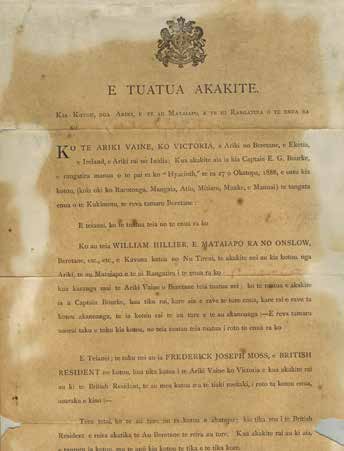
The Proclamation (E Tuatua Akakite)
Cook Islands - The Cook Islands Library and Museum Society
Story
The Proclamation (E Tuatua Akakite) is a fragile, unique, two page document, written in Maori, the language spoken in the Cook Islands. The Proclamation was made in 1888 but not signed by the Earl of Onslow on behalf of Her Majesty Queen Victoria until April 1891. Britain opted for a protectorate which gave the traditional leaders a considerable degree of autonomy while having the protection of the British Crown. The Cook Islands were annexed to New Zealand in 1901 and remained a New Zealand protectorate until self-government in 1965.
There are two significant reasons why the Proclamation was made. Makea, a paramount chief on the island of Rarotonga, sought the protection of the British Crown against a perceived French invasion. This was at a time when Anglo-French relations were poor. New Zealand also sought the protection of prospective trade routes through the proposed Panama Canal given the strategic Pacific location of the Cook Islands. The Proclamation is important for understanding Pacific history as well as Cook Islands history. It marks the beginning of a relationship that continues today with the British monarch as the Head of State of the Cook Islands through the Governor General of New Zealand. It also marks the beginning of the Cook Islands becoming an independent nation with a Westminster style democracy. All Cook Islanders are also New Zealand citizens.
The Proclamation was originally held by the Governor in New Zealand and in the 1950s it was donated by the Resident Commissioner of the Cook Islands to Ngatangiia Are Korero (house of culture/learning) and in 2008 it was transferred to the Cook Islands Library and Museum Society.
Images
Location
Information
- Registration Year:
2014
- Related Repositories
- The Cook Islands Library and Museum Society
- Download
- Nomination Form
